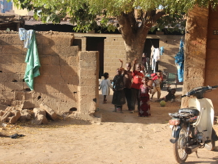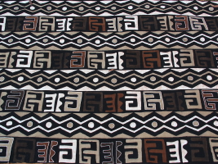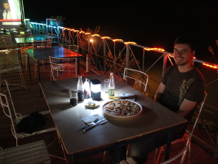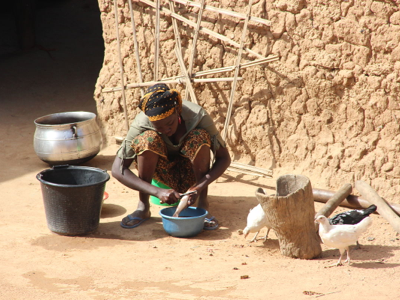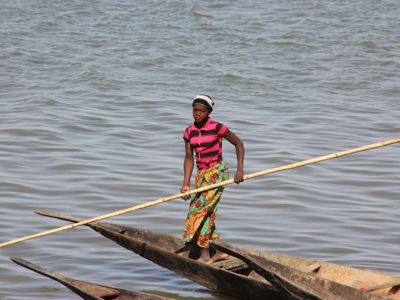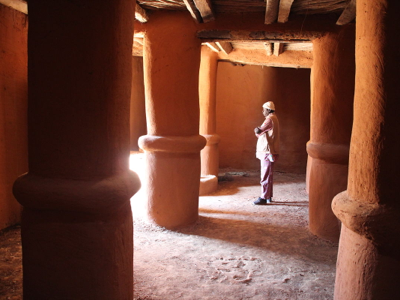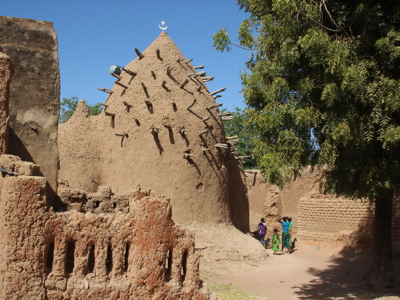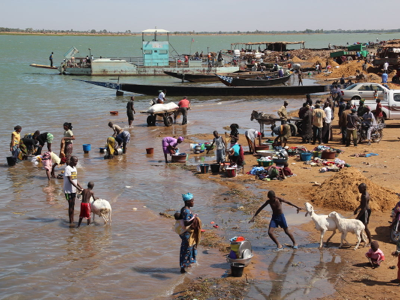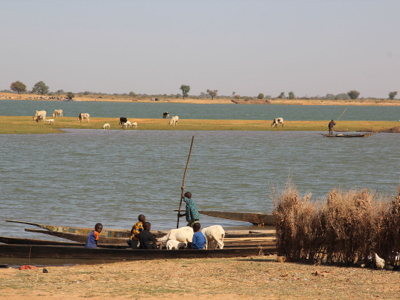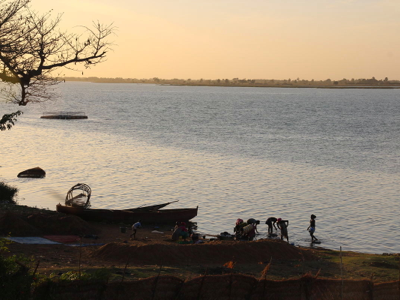From Houston to Sydney 2013

West Africa
2014
When Andrew and I travelled through Mali ten years ago, we only stopped at Segou for a lunch break. Our full day in Segou today has made me realise how much we missed a decade ago.
After waking at 7:00 am, we enjoyed great showers with lots of hot water. I realised how much dust had covered me during yesterday’s drive as the smell of dust permeated the air while I was showering, and the red muddy water drained away at my feet.
Breakfast was basic but filling, comprising several rolls of French bread with jam, butter, cream cheese, fruit juice and coffee. It was not a breakfast for those needing a gluten-free diet, but it suited Andrew and I well.
We were on the road by 8:30 am, and our first stop was the bank beside the River Niger. Although Segou is a few thousand kilometres upstream of the mouth of the river, the river is very wide at this point, and the bank was already a hive of activity with people washing (their clothes, their motor bikes, their cars, their goats and themselves), some industrious loading of river sand into trucks, and cement blocks being manufactured. Several long, thin boats were transporting brightly dressed people across the river, and a larger river ferry was loading. It was a beautiful scene that provided us with an excellent insight into Segou’s everyday morning activity.
We then spent some time walking slowly along the river bank towards the south-west, taking in the sights, sounds and smells of the morning. Every so often we came upon some interesting surprises, such as the colourful stalls selling pottery that had been brought from the opposite side of the river and the colonial era statue of the French Commandant Archinard who conquered the Niger Valley in 1884 – apparently, he is a detested figure among the local Malians because he ruthlessly killed so many local people.
A short nine kilometre drive south-west (upstream) beyond the city limits brought us to our main stop for the morning, the ancient village of Segou-Koro (Old Segou, also known colloquially as Sekoro). Sekoro was the “old, pre-colonial Segou”, capital of the Bambara kingdom before the French conquest. Mama told us that this was a very old village, and when I asked him when it had been established, he helpfully replied “oh, a long time ago”. (Subsequent conversations suggested that the village was between 500 and 600 years old, although the guidebooks quote the 18th century as its foundation period).
This was a truly magical experience. The village is not a vacated ruin – it remains a fully functioning village under the leadership of descendants of the Bambara kings. After parking the car near a large water pool surrounded by mud brick houses, we walked into the centre of the village and were greeted informally by almost 20 young boys who were dressed in blue cloaks with pointed hoods on their heads. The reason for their unusual dress was that they had all been recently circumcised “by a doctor, not like in the old days when it was done by the blacksmith”. I asked how long they would be wearing the blue capes and hoods, and I was told it would be “until they feel comfortable again”.
We walked through a courtyard area where the boys were playing (usually quite vigorously – dare I say “comfortably”), and entered the home of the village chief, who was a direct descendent of King Biton Coulibaly (1712-1755), the first Bambara king, whose tome we would visit a little later during our visit. We were welcomed to the village, and after an exchange of greetings and some photos, we proceeded to explore Segou-Koro under the guidance of the chief’s son.
The first stop in the village was a building surrounding the tomb of King Biton Coulibaly that comprised seven rooms in a linear sequence. The building served as a type of justice court. If a person was accused of a crime, he would be brought to the first room and some elders would consider the case. If an agreement was reached, the accused would pay the penalty and be released. If no agreement was reached, everyone would proceed to the second room, where the process would be repeated.
This continued through the rest of the rooms, with one exception – if no agreement was reached and the accused reached the seventh room, he would meet the king. No hearing would occur in the seventh room; the king would simply order that the accused be killed, an order that was executed immediately (excuse the pun) in the corner of that same room buy slitting the throat of the accused person with a huge knife. Not very reassuringly, if the accused survived having his throat slit with the huge knife, he would be set free (perhaps an extremely tough parallel to getting out of jail in Monopoly by throwing a double, but with worse odds).
Our visit to this “seven room court of justice” (we never heard an official name for the building) finished with a walk on the roof, which gave us some excellent views across the village, with its narrow dusty laneways waving between the decaying mud brick houses.
Leaving the King’s tomb, we walked along some laneways, past a street that a devil-spirit is supposed to inhabit every evening, to a small mosque on the bank of the River Niger. This was a beautiful, peaceful spot with shady trees growing on the sandy banks, and a fascinating cross-section of village life underway – washing clothes, cultivating onions, chasing animals, and travelling in small canoes. It was a fabulous experience just to watch all the activity and absorb the colour and life of the village activities.
Further walking through the village brought us to a small market under the shade of some trees, and then the oldest of the mosques in the village. Interestingly, it was built by King Biton Coulibaly (who was an animist) for his mother, Ba Sounou Sacko (who was a Muslim) in the mid-1700s. Although not the oldest mosque in Mali, it is certainly among the oldest, and featured an unusual beehive-shaped structure.
Although we had seen almost every street in this small village, it seemed to soon to leave when the time came, so we bade farewell and returned to the central area of Segou to visit the Nieleni Co-operative, a women’s co-operative that makes hand-woven woollen rugs. Being Sunday, only one lady was present and the workshop was vacant, although she very kindly demonstrated the process by adding a few pieces of wool to a rug and snipping them with scissors for us. She was more interested in selling us the one small rug they had for sale, and seemed quite disappointed when we declined.
More interesting (to my eyes) that the rug co-operative was the market outside, so before driving away, Mama accompanied Andrew and me as we walked around the market. The focal area of the market was a small mosque, in front of which was a large area selling nicely arranged piles of fuelwood with an impressive fleet of donkeys and carts on hand for transport.
Along the street from the fuelwood was an area selling food and household goods. I was interested to see a stall where pieces of what looked like grey stone were being sold. Mama explained that “these are very bad; the women who do not want babies buy this clay so they become infertile – but four or five years later they want babies, but they can’t have”.
After our walk around the market, we returned to the bank of the River Niger (the same place that we had visited earlier in the morning). The activity on the bank was now much busier, and we took the time to walk down to the sands of the bank and have a close at the action.
Rather than returning to our hotel (which is on the outskirts of Segou) for lunch, we decided to have lunch in the restaurant of another hotel (L’Augerge) that is owned by the same Lebanese man who owns our hotel (the Hotel Independance). On balance, I thought the food was better at L’Auberge. Both Andrew and I opted for the same choice – beef (we think) cordon-bleu with bread and a coke. We also enjoyed the restrooms at the hotel which are perhaps the largest I have yet seen in Mali (that is, if you disregard the banks of the river).
We followed the example of Mama and Harouna and enjoyed a rest during the heat of the day between 2:00 pm and 4:00 pm, at which time we met to head off for three afternoon visits.
Our first destination took some finding, as Mama and Harouna had to ask directions several times to find the place – a private distillery that was making strong alcoholic liquor from fermented sorghum. It is perhaps not surprising that most of the people who were asked for directions knew its location but (being good Muslims) seemed reluctant to divulge its whereabouts.
Eventually we found the distillery, an unmarked private home where the vats and furnace were operating in a small open compound. The process of making the liquor was explained to us in some detail by the mildly inebriated owner before we were invited to partake some of the cloudy green liquid. We declined, noting that even small quantities seemed to be making several of the customers on the nearby drinking benches less than sharp.
Our second stop also took some finding, but eventually we located the “Centre Culturel Kôrè” just off the main highway near the southern outskirts of Segou. Housed in a very well maintained courtyard style complex featuring a museum, a theatre, a meeting room, a sound studio and several outdoor stages, the “Centre Culturel Kôrè” remains something of an enigma to me even though I have read a description of it (admittedly in French) and received a detailed briefing from the very friendly Chargé de Relation Publique, Mr Cheickina Sambakessi.
At first we were told that it was “an association”. I asked whether entry was open, if my son Andrew could join for example, and the answer was “yes”. Clearly it is an association that will admit anyone, and yet as the discussion proceeded, it seemed to morph into a theatre company that helps mediate and communicate social problems, and then into a privately owned organisation that is somewhat like a secret society. For instance, we were shown masks that are used for an undefined form of worship. Moreover, I asked about the meaning or origin of the word “Kôrè”, and was told that the meaning can only be known to those who have been admitted. This was explained, less than helpfully I thought, by using the analogy of the word “land”, which has different definitions for scientists compared with , say, adherents of traditional religions. So, in essence, it seems to be an organisation that promotes traditional music and theatre, but there also seems to be a secretive facet that I was never able to grasp.
Our third and final stop was back near the river banks in central Segou, opposite the Post Office. This was the workshop of a famous Malian textile artist known as Soroble. Soroble was there to greet us, but as it was Sunday, there were no workers and no activity. However, he happily allowed us to venture up to his roof terrace from which some lovely sunset views of the River Niger and its active riverbanks could be seen. It was a very pleasant finale to an excellent day.
Well, almost the finale. We ventured out of the hotel for dinner this evening to a riverside restaurant near central Segou. Owned and operated by (yet another) Lebanese businessman, the Paillote has a terrace that overlooks the Niger River. Well actually, at night, everything beyond the terrace is pitch black, but it was nice to know the river was out there somewhere.
The atmosphere was not helped by the strobing multi-coloured lights that were strung along the edge of the balcony or the unbelievably bad French R&B music that sounded as though it came from another planet. Andrew and I shared a Pizza Marinara before finishing with chocolate crepes. The food was definitely better than the décor, although I imagine that the outlook would be wonderful at, say breakfast time.
Speaking of which, ours tomorrow morning will be at 6:30 am so we can get underway for the long drive to Mopti at 7:00 am. After the great day we have enjoyed today, sleep should be easy.

Day 9 - Segou, Mali
Sunday
5 January 2014





































